Standard lining sizes

Decorating country houses and summer cottages with wooden "cladding" gives them a cozy, nostalgic look both inside and out. A selection of wood trim parts from materials of different texture, shape and quality can have many options. And thanks to the skills of designers and builders, the house will become a masterpiece of wooden architecture.

Where is used
In the manufacture of the first passenger cars, due to the low traction characteristics of steam locomotives of that time, it was required that the weight of the train corresponded to these capacities. Then it was proposed to make the skin of the wagons from boards of a special shape, which ensured a certain tightness of the wagons. Hence the name "Lining".
Clapboard is sheathed or trimmed in various rooms. It is a material for interior wall cladding of rooms, terraces, balconies, loggias, baths, dressing rooms, verandas. Houses with exterior cladding blockhouse and American look good. The need for lining is growing in country house construction and the private sector, decoration of apartments and office premises. The number of proposed new shapes and profiles of lining boards increases every year.


Peculiarities
Lining is a milled, most often wooden board, which is widely used in the construction and decoration of various household premises. This is not a recycled product, but a solid wood material, specially processed for easy assembly when cladding walls, ceilings and other components of housing and utility rooms. The lining material does not contain harmful impurities, with the exception of agents against decay and the action of wood parasites

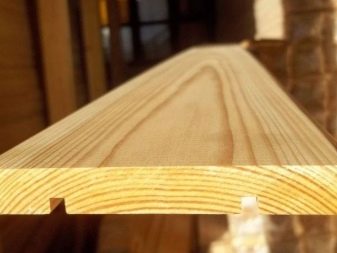
All finished products in the form of lining must meet the requirements of the standards adopted in the EU and Russia.
Main dimensions according to EU standards:
- thickness;
- width (useful);
- length;
- spike size.

The starting material for the production of this type of product is coniferous trees (pine, spruce, larch), as the cheapest and most accessible for processing and use. But hardwood is also often used for expensive cladding.
It must be remembered that conifers, especially spruce and pine, emit resin with strong heating, therefore, different breeds should be combined for sheathing baths to eliminate unpleasant sensations.


For cladding baths and bath rooms, a whole set of tree species is used from which lining can be made. The linden tree occupies a special place here. Its versatile and medicinal properties make it an ideal bathing option.
Essential oils released from linden when heated have many medicinal properties, including anti-inflammatory and antibacterial properties. Staying in a steam room, decorated with linden, relieves colds. In addition, linden resists moisture and retains a long-sanded surface.

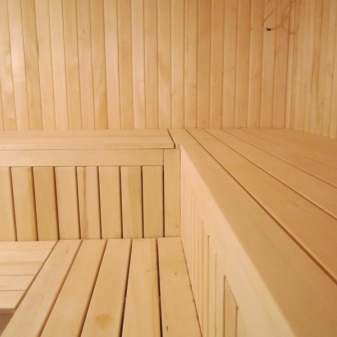
Views
According to the purpose, shape, section, relief, methods of assembling the lining, there can be various options that have already been used for many years in construction practice. There are also new forms offered by designers and developers of building and finishing materials. Different types of wood are used in different ways.

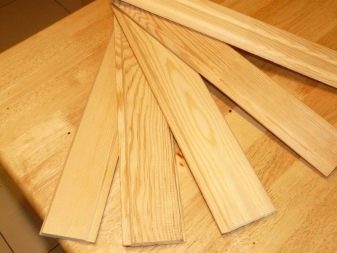
Larch is the most durable wood material, which ranks at the top in popularity among those who live in wood-trimmed houses.
On plots near country houses, walls of houses, entrances, gazebos, verandas are trimmed with larch cladding. A larch porch can decorate a house of any format.On environmental friendliness, this tree species is beyond doubt. When cladding exterior surfaces with material, the attractiveness of the house only increases. Moreover, the external and strength characteristics of larch cladding remain for many years.


An excellent finishing material is alder. Like linden, it has medicinal properties, is perfectly polished, and retains its external characteristics for many years. The tree is not afraid of moisture, gives a feeling of warmth when touched, so it will be very pleasant to sit on the alder trim in the bath.
Wall cladding creates an atmosphere of coziness and comfort. Each type of wood used for the production of lining boards has its own characteristics. Beautiful clapboard decoration of the house both inside and outside gives the home a unique design.


Area calculation
No complicated calculations are required to calculate the area you need. Installation when finishing surfaces inside and outside is often performed independently, and everyone who has taken up the finishing of their house is capable of calculating the working area and the number of lining boards. There are calculators by which the number of lining is calculated.
The required dimensions are entered into the planning table, the calculated quadrature is obtained and divided by the useful area of the unit strip. Get the number of lining for the required coverage area. It will be better and more reliable if you add 10% of the calculation to the results obtained. This data will be accurate for rooms with the same wall height.


Calculation examples
For facing the attic, its area is calculated, sequentially carrying out several actions:
- the entire area is divided into components, the area of which is easy to calculate;
- a table of all measured data is compiled;
- add up all the individual areas of the components;
- the total area is divided by the size of the useful area of one strip of the lining.
To the resulting number of stripes, add 10-15% for trimming, taking into account the complexity of the room configuration. The resulting number of lining boards will be sufficient for facing.


Standard sizes
Interestingly, the tree species also affects the size of the wooden lining. In practice, most often others for the manufacture of this material are used such species as pine, larch, cedar, linden, alder, oak, aspen. The types of rocks also affect the difference in the cost of the material from them. If you make all the calculations correctly, then there will be no overpayment for the purchased volumes of lining.
Below will be given the basic data of the lining board: width, length, thickness. Knowing these dimensions makes it possible to choose the optimal number of lining boards.
There are some differences in varieties:


Aspen
Aspen lining is most often used in the decoration of baths, saunas, and hananes. Manufactured and supplied to the market by Russian and European enterprises. Imported products are characterized by increased requirements for quality, moisture conditions, and dimensions. All requirements are laid down in the EU standard DIN 6.
Our GOSTs are less demanding in quality, so the material is a little cheaper, but both standards are the same in size:
- thickness: 12 - 40 mm;
- width: 76 - 200 mm;
- length: 0.2 m (minimum) - 6 m (maximum).
- thickness: from 12.5 mm to 15.0 mm. (Euro lining - 12.5 mm);
- effective width: 88 mm;
- overall width (dimension);
- length: from 1000 mm to 3000 m.


Oak
Oak lining is durable, durable, beautiful and noble texture. Residential and office buildings, finished with oak clapboard, are distinguished by their natural attractiveness.
The standard dimensions of such a lining:
- thickness: from 12.5 mm to 15.0 mm. (sometimes it happens - 14 mm or 12 × 5);
- width: from 50 to 108 mm (determined by the manufacturer);
- length: from 1000 mm to 3000 mm. (most often 3000 mm, 2700 mm, 2500 mm, 1800 mm.


Pine
The bulk of the lining is produced from pine blanks. Its ease of handling and storage at a low cost makes the material available to most buyers.
Pine lining dimensions:
- thickness: from 12.5 mm to 15.0 mm. (popular - 13 mm, or 12.5);
- width: from 50 mm to 108. (determined in production);
- length: from 500 mm to 3000 mm. (preferred - 3000 mm, 2000 mm, sometimes up to 6 meters).


Larch
Along with the standard dimensions of a conventional lining, factories can also produce lining with data that differ from the standards. However, standard indicators are more often used in construction practice.
Wood paneling standards:
- thickness: 12 - 40 mm;
- width: 76 - 200 mm;
- length: 0.2 m (minimum) - 6 m (maximum);
- spike size: 4-5 mm.
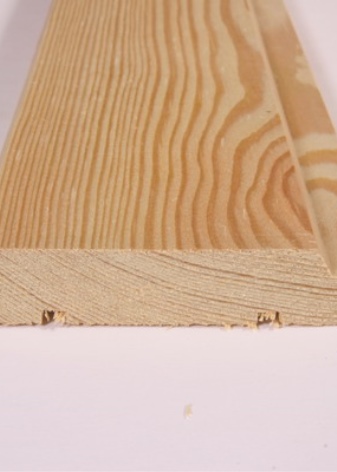

Wood Euro lining standards:
- thickness: 13, 16, 19;
- width: 80, 100, 110, 120 mm;
- length: 0.5 m - 6,000 mm;
- spike size: 8-9 mm.


Permissible deviations:
- thickness: 0.7 mm;
- width: 1 mm;
- length: +/- 5 mm;
- spike size: +/- 0.5mm.


A simple board of the lining type has a fairly wide range of parameters, its thickness is in the range from 1.2 to 2.5 cm, width - from 8 to 15 cm, length - from 60 cm to 6 m.
The EU standard is limited in thickness and width - 12.5x96 mm and uses 4 lengths:
- 2.1 m;
- 2.4 m;
- 2.7 m;
- 3m.


At Russian enterprises, other sizes for mass use can also vary: thickness - 1.3; 1.6 and 1.9 cm with a width of 8, 10, 11 and 12 cm, while the length is limited to 6 meters.
Sometimes, according to individual orders, manufacturers also make lining with specific dimensions. (thickness - 20 mm, width - 120 mm, 125 mm, 140 mm). Euro-lining boards undergo chamber drying, so the standard moisture content of the material is maintained, which should be at the level of 10-15%. Ordinary lining boards are not brought to such humidity, and it remains at a level 2 times higher than the European level. This affects the quality, but reduces the cost of production. Drying in special chambers is very costly in terms of technology and finance.


The main parameter by which you can immediately distinguish the lining from the usual lining board is the size of the spike. In euro lining, it occupies 9% of the board width (or 8 mm), in a conventional lining board, the protrusion is shorter - from 4 to 6 mm. In the boards, made as lining according to EU standards, grooves are made on the back sides for air passage. This prevents condensation from forming and relieves internal stress that can occur during temperature changes.


The difference between euro lining and lining:
- The strict fulfillment of quality requirements is carried out.
- Eurolining boards dried in chambers have a moisture content not exceeding 12%. In an ordinary lining, this indicator is in the range of 15-28%.
- The outer surface of the boards is sanded and does not require further processing after facing.


- Each package with boards is packed in plastic wrap.
- There are more grooves for ventilation and condensate drainage.
- The size of the eurolining spike is 9 mm, the usual one is 5 mm.


Tips & Tricks
When choosing the exact number of lining boards (in terms of usable area, width, net size without a thorn), remember that a short board is cheaper. So 1 m3 of a board with a length of 1.7 meters is almost 1.5 times cheaper than a standard board from 2.1 meters to 3 meters. When trimming, there are inconsistencies, which means you need to take care of which corner to choose and order for the final finishing.
The optimal number of lining boards is calculated according to the useful size (without a thorn). The shorter the length of the board, the lower its price. Therefore, for the choice of lining, dimensions and price remain the determining parameters. The overall financial cost will depend on the surface area that needs to be clapboarded.


The outer surfaces of the premises are sheathed with a special clapboard, which is called "Block house"... One side of this original lining is rounded. The execution of such a surface requires special equipment in order to obtain the same size and shape of the surfaces. The details of the blockhouse, assembled in a specific finish, create the impression of a well-rounded log house. A feature of blockhouses is the ability to replace damaged elements, if necessary, without violating the integrity of the entire finish.


A special type of lining - "American"... In fact, this is a planed board, in which a groove is cut from one end, and a tongue is formed on the other, this allows them to be firmly connected to each other.Chamfers on the side edges of the board create the appearance of a masonry made of wooden beams; it is not immediately possible to guess that this is an "American" finish.


Although it is also a lining for its intended purpose, but due to its impressive appearance, strength, width, weight, it is used only for external cladding. The house after finishing American takes the form of a solid log structure. Of course, if you wish, you can use the material for interior decoration, but in this case, part of the interior space of the room will be reduced.
The total usable area of the entire billet must be calculated very carefully and carefully so that at the end of the work there is no need to urgently add the missing number of lining boards due to poor calculations or the appearance of a large number of unusable elements.

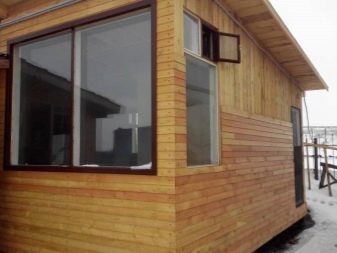
For information on how to choose the right lining, see the next video.













The comment was sent successfully.